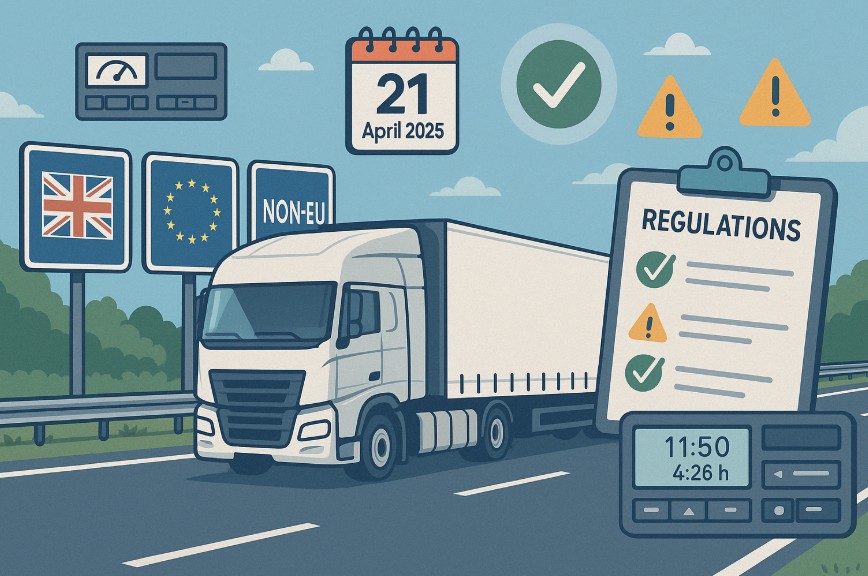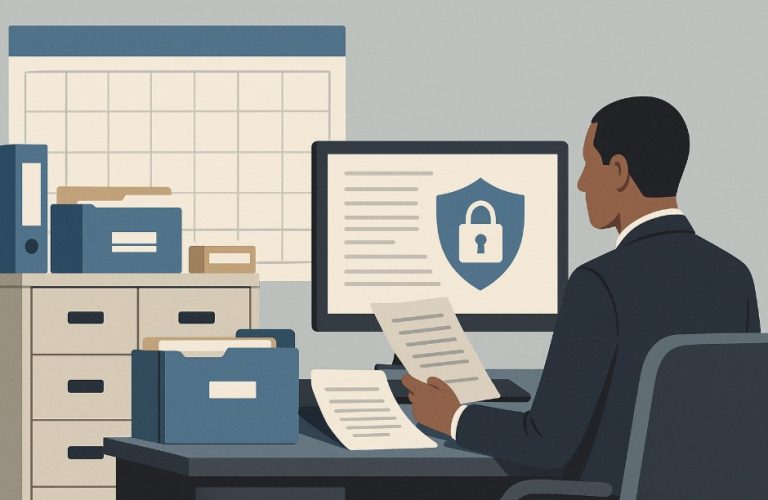DVSA HGV Drivers Hours Rules Changes: How New Regulations Impact Fleet Management
Are your fleet operations prepared for the most significant DVSA drivers’ hours regulations overhaul in recent years? Effective from Monday, 21 April 2025, the Driver and Vehicle Standards Agency (DVSA) will implement a series of changes that redefine how international HGV journeys are regulated and monitored.
These adjustments align the UK with its obligations under the UK/EU Trade and Cooperation Agreement, specifically adopting aspects of the AETR (European Agreement Concerning the Work of Crews of Vehicles Engaged in International Road Transport) for international journeys.
These updates signal a major shift in how fleet operators, especially those crossing international borders, must manage driver schedules, rest periods, and digital compliance systems. While the rules for domestic UK journeys remain unchanged, international operators must understand and apply these new standards without delay.
What Are the Latest DVSA HGV Drivers Hours Rules Changes in 2025?

From 21 April 2025, several pivotal rule changes will come into effect for HGV operators undertaking international journeys. These revisions introduce AETR rules for cross-border transport and require updates to tachograph usage, recordkeeping, and vehicle equipment standards.
Summary of Key Updates:
| Category | Before 21 April 2025 | After 21 April 2025 |
| Drivers’ hours regulation | EU 561/2006 (retained EU law) | AETR (for international journeys only) |
| Record retention for international trips | 28 days | 56 days |
| Tachograph requirement | Smart Tachograph v1 acceptable | Must upgrade to Smart Tachograph v2 by deadlines |
| Applicable region | UK and EU countries | Expanded to non-EU international journeys |
This change primarily affects operators travelling to, from, or through non-EU countries. Vehicles involved in such trips—regardless of country of registration must now comply with AETR rules.
What Are the Legal Driving Hours and Rest Break Requirements for HGV Drivers?
Under EU and AETR Rules
These remain broadly consistent with current UK practices but now enforce stricter evidence and monitoring obligations. All international drivers must follow the driving and rest standards defined under the AETR, as summarised below:
| Activity | AETR/EU Limit |
| Daily driving limit | 9 hours (extendable to 10 hours twice a week) |
| Weekly driving limit | 56 hours |
| Fortnightly driving limit | 90 hours across two weeks |
| Daily rest period | 11 hours (can reduce to 9 hours three times per week) |
| Weekly rest period | 45 hours (can reduce to 24 hours once every two weeks) |
| Driving breaks | 45 minutes after 4.5 hours of driving |
| Consecutive reduced rests (goods) | Allowed if both occur outside the UK and driver’s country of residence |
It’s also worth noting that coach drivers on international journeys may take their weekly rest after 12 consecutive 24-hour periods, provided certain conditions are met.
How Does the DVSA Enforce Drivers’ Hours Rules and What Are the Penalties?

The DVSA’s enforcement model has become increasingly proactive, driven by remote access to digital tachograph data, ANPR surveillance, and intelligence-led roadside inspections. The agency can now identify potential infringements before a vehicle is even stopped.
Enforcement Mechanisms:
- Digital data reviews via Smart Tachograph 2
- On-the-spot fines and prohibition notices
- Fleet audits and record inspection
- Warning letters and eventual O-licence reviews for repeat offences
| Offence Type | Typical Penalty |
| Minor breach (e.g. missed break) | £50 to £100 fixed penalty notice |
| Serious breach (e.g. false record) | £300 and potential prosecution |
| Multiple offences | Prohibition, re-training, licence suspension |
Fleet operators must ensure that internal monitoring systems are aligned with DVSA expectations, not only to prevent penalties but also to demonstrate due diligence in case of an inspection.
How Do the 2025 DVSA Rules Affect Fleet Management and Operations?
For UK fleet operators involved in international logistics, these rule changes will necessitate a strategic overhaul of operational protocols.
Major Impacts on Fleet Operations
- Data Management
Operators must now store 56 days of driving records, including:- Digital tachograph downloads
- Analogue charts (if applicable)
- Any manual entries or corrections
- Route Planning
With stricter rest enforcement, route planners must allow time for compliant rest breaks, especially during congested border crossings or ferry delays. - Driver Scheduling
Timetables must now account for extended rest rules. Automated scheduling systems should be updated to reflect new thresholds. - Training & Compliance
All personnel involved in transport planning, including drivers, need to be familiar with AETR protocols and how they diverge from standard EU or UK rules. - Cross-Border Awareness
Operators must understand which rules apply depending on route:- EU journeys: Follow EU drivers’ hours
- Non-EU international: Apply AETR rules
- Domestic only: Continue with UK assimilated law
How Do Tachographs and Digital Monitoring Help with DVSA Compliance?

As of 2025, Smart Tachograph 2 becomes the gold standard for monitoring international journeys. These devices offer real-time communication, enhanced GPS, and automated border detection, which helps both enforcement agencies and fleet operators.
Retrofit Deadlines
| Vehicle Type | Deadline for Smart Tachograph 2 Installation |
| Vehicles with existing Smart Tachograph 1 | By 18 August 2025 |
| Vehicles between 2.5 and 3.5 tonnes GVW | By 1 July 2026 |
Operators must also ensure data is backed up and readable across all devices, as DVSA can request evidence of tampering or incomplete logs during inspection.
How Do EU Drivers’ Hours Rules Differ from UK DVSA Regulations?
The UK has retained most EU rules for domestic enforcement but differentiates international enforcement based on route and destination.
Summary Comparison:
| Aspect | UK Only (Domestic) | EU Rules (EU Routes) | AETR (International Routes) |
| Legal Framework | Assimilated UK law | EU Regulation 561/2006 | AETR Agreement |
| Return to Base Requirements | Required | Required | Not applicable |
| Weekly Rest Interruption | Permitted in some cases | Permitted | Not permitted |
| Smart Tachograph 2 Requirement | No (unless EU trips) | Yes | Yes |
| Record Retention Requirement | 28 days | 28 days | 56 days |
Fleet operators must adapt their procedures depending on whether journeys remain within the UK, enter the EU, or go beyond into third-party countries such as Norway or Switzerland.
What Do the New Rules Mean for Driver Wellbeing and Fatigue Management?
Improving driver wellbeing remains a core goal of these changes. The DVSA recognises that fatigue is one of the leading causes of HGV incidents. As such, ensuring drivers are properly rested—and that rest is properly recorded—is not just a compliance issue, but a safety imperative.
Key considerations:
- All journeys must allow for legally mandated rest periods
- Accommodation for weekly rest must meet minimum comfort standards
- Operators are responsible for ensuring drivers do not skip rest to meet delivery targets
- Failure to manage fatigue appropriately may be viewed as operator negligence
Fleet managers should conduct internal fatigue risk assessments, provide training on sleep hygiene, and make regular rest checks part of driver check-ins.
How Can Fleet Operators Prepare for the 2025 DVSA Changes?

Preparation is critical to avoiding disruption. Here’s a practical roadmap for readiness:
| Preparation Step | Recommended Timeline |
| Review current recordkeeping processes | Immediate |
| Train drivers on AETR rules and distinctions | Within 2–4 weeks |
| Retrofit Smart Tachograph 2 (if applicable) | Before 18 August 2025 |
| Update driver scheduling and route planning tools | Within 1 month |
| Subscribe to DVSA updates and bulletins | Ongoing |
| Review contracts and penalties with hauliers | As soon as possible |
Operators in Northern Ireland should also expect tailored guidance updates, which will be released by the Department for Infrastructure to reflect local legislative contexts.
What Are the Key Takeaways for UK Fleet Operators in 2025?
The 2025 DVSA changes represent a clear pivot toward stricter, internationally harmonised compliance, especially for logistics firms operating outside the UK. Ignoring or misunderstanding the requirements could lead to hefty penalties, reputational damage, or operational delays.
Summary Points:
- The rules do not apply to domestic-only operations
- AETR compliance is mandatory for international travel
- Operators must maintain 56 days of records
- Smart Tachograph 2 installation is required on a strict deadline
- Driver training and compliance audits are essential for avoiding penalties
By approaching these changes proactively, UK fleet operators can ensure smooth international operations and demonstrate leadership in safety and compliance.
Frequently Asked Questions
When do the new DVSA drivers’ hours rules come into force?
The new regulations take effect on Monday, 21 April 2025, and apply to all HGVs operating internationally.
Do I need to change anything if I only operate within the UK?
No, if your vehicles and operations are solely within the UK, the existing domestic drivers’ hours rules remain in place.
What is the difference between EU and AETR rules?
While similar, AETR rules exclude certain EU-specific provisions like returning to base or accommodating rest in specific locations, and require longer recordkeeping (56 days).
Are all HGVs required to upgrade to Smart Tachograph 2?
Only vehicles operating internationally are required to upgrade. However, many operators are choosing to standardise across their fleets.
Will DVSA provide updates specific to Northern Ireland?
Yes, DVSA and the Department for Infrastructure will publish tailored guidance for operators based in or travelling through Northern Ireland.
How can I train my drivers on the new rules?
DVSA and Logistics UK offer e-learning modules, webinars, and printed handbooks. Operators should incorporate this into CPC and onboarding.
What happens if I fail to keep 56 days of tachograph records?
This is considered a serious compliance breach and can result in fines, penalties, or even suspension of your operator licence.







